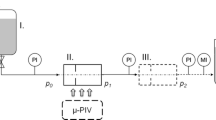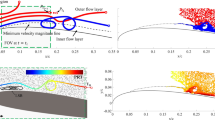Abstract
The flow structure of the vortex tube is considered to be the key to understanding the energy separation mechanism, and the unsteady vortex breakdown and precessing vortex core determine the characteristics and behaviour of the flow structure. Thus, transparent vortex tubes with a diameter of 30 mm were designed for main tube visualization, and two-dimensional (2-D) particle image velocimetry (PIV) measurement was adopted to investigate the instantaneous and time-averaged flow field on the meridian plane. The distributions of the axial velocity, radial velocity, vorticity, and, especially, the reverse flow boundaries were obtained to understand the flow structure within vortex tubes. Various operating conditions with different cold mass fractions (0.1–0.9), tube lengths (360, 600, and 900 mm), and inlet pressures (0.1 and 0.2 bar) were studied to reveal the effects of the reverse flow boundary on the energy separation performance. The large-scale flow structure of the precessing vortex core was found to be located at the reverse flow boundary, and the vortex core precession determines the mass transfer processes between the inner and outer layers. In addition, the axial velocity fields and the distributions of the reverse flow boundary captured by the 2-D PIV agree with our earlier results from 2-D laser Doppler velocimetry to a great extent, confirming the feasibility of these two laser nonintrusive measurement methods and the streamline results from our earlier LES study.
Graphical abstract

















Similar content being viewed by others
References
Baghdad M, Ouadha A, Imine O, Addad Y (2011) Numerical study of energy separation in a vortex tube with different RANS models. Int J Therm Sci 50:2377–2385
Bazgir A, Nabhani N, Eiamsa-ard S (2018) Numerical analysis of flow and thermal patterns in a double-pipe Ranque-Hilsch vortex tube: Influence of cooling a hot-tube. Appl Therm Eng 144:181–208
Behera U, Paul PJ, Kasthurirengan S, Karunanithi R, Ram SN, Dinesh K, Jacob S (2005) CFD analysis and experimental investigations towards optimizing the parameters of Ranque-Hilsch vortex tube. Int J Heat Mass Trans 48:1961–1973
Behera U, Paul PJ, Dinesh K, Jacob S (2008) Numerical investigations on flow behaviour and energy separation in Ranque-Hilsch vortex tube. Int J Heat Mass Trans 51:6077–6089
Bovand M, Valipour MS, Eiamsa-ard S, Tamayol A (2014) Numerical analysis for curved vortex tube optimization. Int Commun Heat Mass Trans 50:98–107
Bramo AR, Pourmahmoud N (2011) CFD simulation of length to diameter ratio effects on the energy separation in a vortex tube. Therm Sci 15:833–848
Burow EJ, Doll U, Klinner J, Stockhausen G, Willert C (2016) Development of laser-optical measurement techniques on the vortex tube: taking PIV to its limits. In: 18th international symposium on the application of laser and imaging techniques to fluid mechanics, Lisbon, Portugal
Chen J, Zeng R, Zhang W, Qiu L, Zhang X (2018) Numerical analysis of energy separation in Ranque-Hilsch vortex tube with gaseous hydrogen using real gas model. Appl Therm Eng 140:287–294
Devade KD, Pise A (2017) Parametric review of ranque-hilsch vortex tube. Am J Heat Mass Trans 4:115–145
Eiamsa-ard S, Promvonge P (2008) Numerical simulation of flow field and temperature separation in a vortex tube. Int Commun Heat Mass Trans 35:937–947
Farouk T, Farouk B (2007) Large eddy simulations of the flow field and temperature separation in the Ranque-Hilsch vortex tube. Int J Heat Mass Trans 50:4724–4735
Fröhlingsdorf W, Unger H (1999) Numerical investigations of the compressible flow and the energy separation in the Ranque-Hilsch vortex tube. Int J Heat Mass Transf 42:415–422
Guo X, Zhang B (2018a) Computational investigation of precessing vortex breakdown and energy separation in a Ranque-Hilsch vortex tube. Int J Refrig 85:42–57
Guo X, Zhang B (2018b) Analysis of the unsteady heat and mass transfer processes in a Ranque-Hilsch vortex tube: tube optimization criteria. Int J Heat Mass Trans 127:68–79
Guo X, Zhang B, Liu B, Xu X (2019a) A critical review on the flow structure studies of Ranque-Hilsch vortex tubes. Int J Refrig 104:51–64
Guo X, Zhang B, Li L, Liu B, Fu T (2019b) Experimental investigation of flow structure and energy separation of Ranque-Hilsch vortex tube with LDV measurement. Int J Refrig 101:106–116
Guo X, Zhang B, Shan Y (2021a) LES study on the working mechanism of large-scale precessing vortices and energy separation process of Ranque-Hilsch vortex tube. Int J Therm Sci 163:106818
Guo X, Liu B, Zhang B, Shan Y (2021b) Analysis on the patterns of precessing frequency characteristics and energy separation processes in a Ranque-Hilsch vortex tube. Int J Therm Sci 168:107067
Kazantseva OV, Piralishvili SA, Fuzeeva AA (2005) Numerical simulation of swirling flows in vortex tubes. High Temp 43:608–613
Kobiela B, Younis BA, Weigand B, Neumann O (2018) A computational and experimental study of thermal energy separation by swirl. Int J Heat Mass Trans 124:11–19
Kolmes EJ, Geyko VI, Fisch NJ (2017) Heat pump model for Ranque-Hilsch vortex tubes. Int J Heat Mass Trans 107:771–777
Lagrandeur J, Poncet S, Sorin M (2019) Review of predictive models for the design of counterflow vortex tubes working with perfect gas. Int J Therm Sci 142:188–204
Li N, Jiang G, Fu L, Tang L, Chen G (2019) Experimental study of the impacts of cold mass fraction on internal parameters of a vortex tube. Int J Refrig 104:151–160
Liew R, Zeegers JC, Kuerten JG, Michalek WR (2012) Maxwell’s demon in the Ranque-Hilsch vortex tube. Phys Rev Lett 109:54503
Liew R (2013) Droplet behaviour and thermal separation in ranque-hilsch vortex tubes, 'Vol.' PhD dissertation, Technische Universiteit Eindhoven
Manimaran R (2017) Computational analysis of flow features and energy separation in a counter-flow vortex tube based on number of inlets. Energy 123:564–578
Moffat RJ (1985) Using uncertainty analysis in the planning of an experiment. Trans ASME J Fluids Eng 107:173–178
Pourmahmoud N, Hassanzadeh A, Moutaby O (2012) Numerical analysis of the effect of helical nozzles gap on the cooling capacity of Ranque-Hilsch vortex tube. Int J Refrig 35:1473–1483
Rafiee SE, Sadeghiazad MM (2017) Improving the energetical performance of vortex tubes based on a comparison between parallel, Ranque-Hilsch and double-circuit vortex tubes using both experimental and CFD approaches. Appl Ther Engi 123:1223–1236
Ranque GJ (1933) Experiments on expansion in a vortex with simultaneous exhaust of hot air and cold air. J Phys Radium (paris) 4:112–114
Secchiaroli A, Ricci R, Montelpare S, Alessandro VD (2009) Numerical simulation of turbulent flow in a Ranque-Hilsch vortex tube. Int J Heat Mass Trans 52:5496–5511
Thakare HR, Parekh AD (2014) CFD analysis of energy separation of vortex tube employing different gases, turbulence models and discretisation schemes. Int J Heat Mass Trans 78:360–370
Xue Y, Arjomandi M, Kelso R (2013a) The working principle of a vortex tube. Int J Refrig 36:1730–1740
Xue Y, Arjomandi M, Kelso R (2013b) Experimental study of the thermal separation in a vortex tube. Exp Ther Fluid Sci 46:175–182
Xue Y, Binns JR, Arjomandi M, Yan H (2019) Experimental investigation of the flow characteristics within a vortex tube with different configurations. Int J Heat Fluid Flow 75:195–208
Yilmaz M, Kaya M, Karagoz S, Erdogan S (2009) A review on design criteria for vortex tubes. Heat Mass Trans 45:613–632
Zhang B, Guo X (2018) Prospective applications of Ranque-Hilsch vortex tubes to sustainable energy utilization and energy efficiency improvement with energy and mass separation. Renew Sustain Energy Rev 89:135–150
Zhang B, Guo X, Yang Z (2016) Analysis on the fluid flow in vortex tube with vortex periodical oscillation characteristics. Int J Heat Mass Trans 103:1166–1175
Acknowledgements
This work was supported by the National Natural Science Foundation of China (No. 51876020), Nature Science Foundation of Liaoning Province (No.2020-BS-065), and Basic Science Research Fund in Dalian University of Technology (No. DUT22RC(3)042). We give our sincere thanks for the help from Beiting Measurement Technique Co. ltd and ILA GmbH for the PIV measurement.
Author information
Authors and Affiliations
Corresponding author
Ethics declarations
Conflict of interest
There are no conflicts of interest.
Additional information
Publisher's Note
Springer Nature remains neutral with regard to jurisdictional claims in published maps and institutional affiliations.
Rights and permissions
Springer Nature or its licensor holds exclusive rights to this article under a publishing agreement with the author(s) or other rightsholder(s); author self-archiving of the accepted manuscript version of this article is solely governed by the terms of such publishing agreement and applicable law.
About this article
Cite this article
Shi, Z., Guo, X., Zhang, B. et al. Large-scale flow structure and energy separation in a Ranque–Hilsch vortex tube with particle image velocimetry measurement: an experimental study. J Vis 26, 45–59 (2023). https://doi.org/10.1007/s12650-022-00873-4
Received:
Revised:
Accepted:
Published:
Issue Date:
DOI: https://doi.org/10.1007/s12650-022-00873-4




